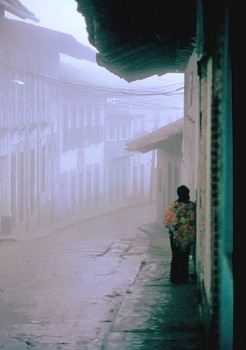Did You Know…?
Many Mexicans, especially campesinos, who are closer to the land than most, believe that the weather during the month of January serves as a long-range forecast for the entire year. The precise prediction system is thought to be based on long cycles of observations carried out in an age when people depended far more on the weather than they do today. The system is quite complicated.

The first twelve days of January are known as las cabañuelas “a derechas”. The weather on January 1 foretells the likely weather for the rest of the month. The weather on January 2 predicts the weather for February and so on, with the weather of January 12 suggesting likely conditions for December. The next twelve days (January 13 to 24 inclusive) are known as las cabañuelas “a rataculas”. This time, the weather of January 13 foretells December, that of January 14 November, and so on.

Next, each of the six days from January 25 to January 30 inclusive is divided at noon. The morning of January 25 represents January, the afternoon February. The morning of January 26 hints at March’s weather, while the afternoon applies to April’s, and so on.
Finally, even the 24 hours of January 31 are used. Each hour in the morning will be reflected in the weather from January to December. (Presumably the weather from midnight to 1.00am is a true reflection of what has already happened in January!) Then, each hour in the afternoon can be used to forecast future weather in the reverse direction. Hence, noon to 1.00pm 1 gives us clues for December, 1.00 to 2.00pm for November and so on. Apparently, an alternative version, used in some parts of northern Mexico, divides January 31 into 12 periods of 2 hours each, with each division corresponding to the months in reverse order.
Whatever the details, the system is said to be at least as reliable as scientific forecasts over the same time period. (Though, thinking about it, perhaps that is not that hard!)
The same cabañuelas system is used in various parts of Spain, but the annual forecast does not always begin on the same day. For instance, in Alcozar, las cabañuelas “a derechas” begin on December 13. Elsewhere in Spain, they start on August 2 or August 13. According to Divina Aparicio de Andrés, predictions in Alcozar based on las cabañuelas lasted until well into the 1940s, but their use has declined since.

The historical origins of the word cabañuelas are unclear. Some sources claim that the system’s roots lie in the Old World, and go back well before the Spanish colonization of the New World. Writing in Mexico Desconocido, Homero Adame claims that the origins date back to the Zumac, or “Festival of Luck”, in the Babylonian calendar. The term cabañuelas may be connected to the Hebrew version, which was the “Festival of the Tabernacles”. Adame also points out that twelve days in the middle of winter were used in India to forecast the future weather conditions. He applies the lore of las cabañuelas to the weather experienced in the city of San Luis Potosí in 2001, finding that it does a fairly good (though not perfect) job of predicting the weather later in the year.
However, an alternative viewpoint is argued by Graciela Minaya, in an article originally published in 1945, in La Nación, a Mexico City daily. She views las cabañuelas as an example of the common heritage of the ancient indigenous peoples of Mexico, central America, and the larger Caribbean islands, that was passed down from one generation to the next. This would explain the variability in details from one country to another.
In her view, las cabañuelas were probably handed down from the Maya. The Maya calendar had 18 months, each of 20 days, followed by five additional “non-month” days. The Maya version of las cabañuelas used the first 18 days of the first month to predict the weather for the year (18 months). To complete the system, the 19th day of the first month predicted the weather for the summer solstice and the 20th the weather for the winter solstice.
The Maya version was known as Chac-chac. For those who are curious, the 18 months are: pop, uo, zip, zots, tzec, xul, yakin, mol, chen, yax, zac, ceh, mac, kankin, muan, pax, kayab, cumhú. The spare 5 days are known as uayeb. The days of each month went in the following order: ik, akbal, kan, chiechán, cimí, manik, lamat, muluc, oe, chuen, eb, bon, ix, men, cíb, cabán, eznab, cauac, ahua, imix. Minaya argued that the 16th day, cabán, gave rise to the word cabañuelas, presumably because it had some additional significance, perhaps in terms of some other calendric calculation, or time-marker.

The testimony of Román Pané, a monk of the order of St. Geronimo, who accompanied Columbus on his second voyage, lends credence to the idea that las cabañuelas originated in the New World. While in Haiti, Pané recorded the fact that “these Indians know by consulting their gods and observing the first days of the year which days will be good, which will be bad, which will be rainy and which dry.” (Loosely translated from what is the earliest purely ethnographic treatise on American Indians.) Pané, incidentally, is thought to have been the first person to take tobacco back to Spain.

How did the Maya come up with the system in the first place? They had already undertaken sophisticated astronomical observations and had developed advanced mathematical and calendric systems, even to the point of being able to predict the arrival of some comets. So, perhaps by long and patient observation of their weather patterns, they had also amassed evidence of cyclical weather phenomena.
Whatever their origin, las cabañuelas will begin once again next month, giving us all another opportunity to record the weather and see if they really work in the twenty-first century.
Listen carefully as you go about your daily business early in the New Year. Perhaps in early January, when the 8th of the month is cloudy and rainy, you’ll hear someone say, “¡Ay! es que estamos en la cabañuela de agosto”. (We are in the August cabañuela). You’ll know exactly what they are talking about! Chac, the Maya rain god, and Kukulcan, the Maya wind god, will be proud of you!
Note:
This article is reprinted as Chapter 26 of the author’s Mexican Kaleidoscope: myths, mysteries and mystique (Sombrero Books, 2016).
Sources:
- Divina Aparicio de Andrés (1978). Las cabañuelas. https://orbita.starmedia.com/alcozar-soria/cabanuelas.htm
- Graciela Minaya (1945) Las cabañuelas y su origen. Originally published in La Nación. Published on web at https://www.acqweather.com/cabanuelas.htm
- Homero Adame Martínez (2002). Las cabañuelas, conocimiento emprírico del clima. México Desconocido No.299, pp. 26-34.
- Román Pané (1571). Documentos ineditos de Indias. His report predates 1508 but was first published in Italian (1571).
Text and all photos © Copyright 2002, 2004 by Tony Burton. All rights reserved.
